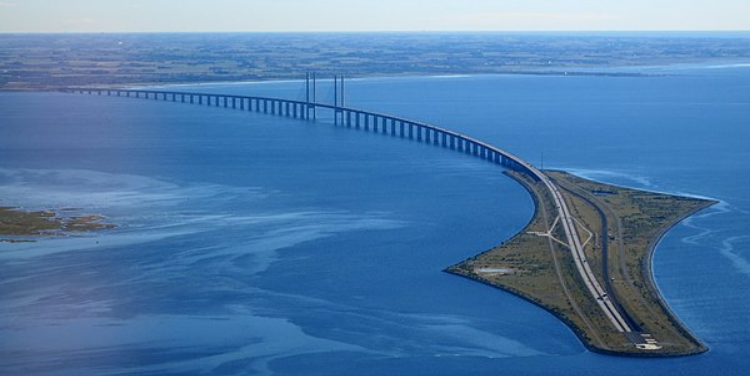On January 3rd, an AP article reported that "After one million migrants, Europe's borders are back".
The article begins by discussing the impressive Oresund Bridge in the Oresund Strait between Sweden and Denmark. It's a 5-mile bridge running from Scania, Sweden to an artificial island called Peberholm. From there, the 2.5 mile tunnel can take travelers to the Danish island of Amager. (Or, if one is traveling from Denmark to Sweden, just reverse the process).
Since it opened in 2000, the Oresund bridge between Sweden and Denmark has been a towering symbol of European integration and hassle-free travel across borders that people didn't even notice were there. On Monday new travel restrictions imposed by Sweden to stem a record flow of migrants are transforming the bridge into a striking example of how national boundaries are re-emerging. A year of clampdowns on migration and terrorism has all but killed the idea of a borderless Europe where you could drive or train-hop from Spain in the south to Norway in the north without ever having to show your passport. After 1 million migrants, Europe's borders are back Karl Ritter, AP, January 3, 2016
The Oresund bridge is being used by the AP writer as a symbol of how Europe's borders are being tightened. Is that a bad thing? I guess so, if you're a globalist.
The article quotes a Swedish professor complaining about the bridge being treated as an actual border.
"We're turning back the clock," said Andreas Onnerfors, who lives in Lund, on the Swedish side of the bridge. An associate professor in intellectual history, he said he's benefited from the free flow of people and ideas across the bridge — he's studied on both sides and taught students from both Sweden and Denmark. "We're going back to a time when the bridge didn't exist," he said, referring to the ID checkpoints being set up Monday on the Danish side for train passengers wishing to cross over to Sweden.
Notice the bait and switch. Swedes and Danes are kindred northern European peoples who speak mutally intelligible languages. Having Swedes and Danes traverse freely across a bridge is hardly the same as having hordes of Middle Easterners storm through, demanding asylum and benefits, not to mention bringing with them possible violence and terrorism.
Even the AP writer points out the real reason for bridge security.
The move is meant to stop undocumented migrants from reaching Sweden, which abruptly reversed its open-door policy after receiving more than 160,000 asylum-seekers last year, mainly from Syria, Iraq and Afghanistan.
In fact, various countries of Western Europe are beefing up their borders.
It follows the reintroduction of border checks in Germany, Austria, France, Belgium and other countries in what's supposed to be a passport-free travel zone spanning 26 nations. The moves are supposedly temporary, but are likely to be extended if Europe's migrant crisis continues in 2016. "It's basically every country for itself now," said Mark Rhinard, an expert on the European Union at the Swedish Institute of International Affairs. Citing exceptional national circumstances related to security, terrorism and public order, several European countries have suspended EU rules that required them to keep their borders open to each other. It's a significant development that strikes at the very heart of the EU project — the free movement of goods and people across borders.
The Bruegel think tank in Brussels says that in 2014 there were almost 1.7 million cross-border commuters in the passport-free zone known as the Schengen Area, after the Luxembourg town where it was created in 1985. Abolishing it would affect their daily lives, but the consequences for Europe would go deeper, given the "visible and powerful symbol of European integration that Schengen represents," Bruegel researchers Nuria Boot and Guntram Wolff wrote in December.
Whether the temporary reintroduction of borders also means rebuilding mental boundaries between EU citizens remains to be seen. But the migrant crisis is becoming an even bigger challenge to European unity than the cracks emerging in recent years over the bloc's common currency, the euro.
EU nations demonstrated starkly different views on how to deal with the 1 million migrants that crossed the Mediterranean in 2015. Germany and Sweden, until recently, said refugees were welcome, while Hungary built a fence to keep them out. The Danish government took a series of measures to discourage migrants from going there, including a proposal to seize their jewelry to cover their expenses in Denmark.
Common rules requiring refugees to seek shelter in the first EU country they enter collapsed, as Greece and Italy were overwhelmed by sea arrivals and countries further north just waved the migrants through to their intended destination, often Germany or the Scandinavian countries.
Meanwhile the EU's efforts to spread refugees more evenly across the bloc met stiff resistance from member states. By November only about 150 of 160,000 refugees had been relocated from Greece and Italy under an EU plan.....
The article ends up talking about the bridge again, and with Dr. Onnerfors' complaint.
"This is what happens when national states put down their foot down and say security is most important," said Onnerfors. "It collides with the freedom (of movement) they've been talking about for 20 years, which was the reason we joined the EU to begin with."
When were Europeans informed that freedom of movement within Europe would lead the way to a Middle Eastern invasion?













